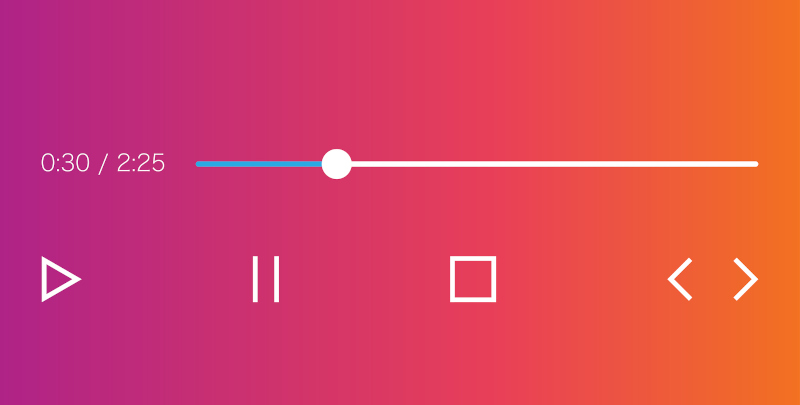With a myriad of distractions competing for our attention, does your learning content have what it takes to keep the spotlight firmly focused on it? Catherine Molloy considers what learning designers can glean from the music industry about creating irresistible, attention-grabbing content.
Spotify, Apple Music, Amazon Music, Deezer or any other platform of your choice - if you have a paid music streaming account, you’re in good company. With over 341 million accounts across the world, music streaming now accounts for 56% of global music revenue.[1]
Offering instant, easy access to a wide music library and the ability to connect socially via shared playlists, they’re a convenient and social way to listen to the music you love.
Streaming platforms have changed how we listen to music
With so much choice at our fingertips, it’s easy to skip tracks or artists when our mood changes or our attention wanes. But could this wealth of musical choice actually be making your attention span shorter?
A recent study by researchers at the Technical University of Denmark[2] suggests so. For digital media in general, their findings show the collective global attention span is narrowing due to the amount of information presented to the public. The study shows people now have more things to focus on – but they often focus for short periods of time.[3]
Data from streaming platforms supports these findings. “All the streaming data shows our attention spans are getting shorter”, explains songwriter Helienne Lindvall.
“Tracks on Spotify and other platforms are skipped within the first 5 seconds on average. Tik-Tok, a huge driver for getting in the charts, delivers music content in 10-15 second chunks.”[4]
It’s not just our listening behaviour that’s changing though…
“Song writing in the streaming age is undergoing a revolution. Streaming technology and services…haven’t just changed the way we consume or listen to music; they’re transforming the way music is created.” Helienne explains.
With an endless supply of songs for listeners to choose between, songwriters are already adapting the way they write music in order to grab attention quickly and hold it for as long as possible… or, crucially, to keep you listening to their song long enough for the platform to pay their royalty.
Tom Grey, songwriter, producer, and founding member of 90’s band Gomez, explains: “A stream counts after 30 seconds. So, the most important thing to a songwriter is to keep you in until you get to the 31st second, the moment at which they earn their tiny micropayment. So they need you to stay there for that first 30 seconds.”

Musicians only get their micropayment when a song is streamed for more than 30 seconds.
And, as you might infer, listener convenience aside, it’s not all rosy for streaming services. Inequity of artist revenue is an ongoing matter of contention, leading to a UK Parliament inquiry on the economics of music streaming[5][6], as is the issue of streaming data creating a feedback loop which is narrowing the breadth of music being produced.
It is undeniable, however, that today’s songwriters have learned a trick or two about grabbing and holding listeners’ attention and, as Lindvall explains, they are “already adapting the way they write music in order to grab attention quickly”.
What does this tell us for L&D purposes?
While you might not instantly connect the world of learning and development with the music streaming industry, there are some obvious parallels. Both are delivering increasing amounts of digital content to an easily distracted, attention-scarce audience.
So, what can we in learning and development learn from today’s songwriters about captivating our audiences’ attention?
Here are 4 tips.
1. Grab immediate attention
Songwriter and producer Tre Jean-Marie knows he needs to catch the listener right from the beginning with something catchy and distinctive. “I try to make sure that we’re going straight into the song whether that be some earworm or a chorus”.
It’s a pattern that’s catching on – “there is a new song structure we’ve observed that we’ve called the pop overture, where a song, at the very beginning, will play a hint of the chorus in the first five to 10 seconds so that the hook is in your ear, hoping that you’ll stick around till about 30 seconds in when the full chorus eventually comes in.”[7]
You need your learning content to capture your audience’s attention upfront; something distinctive that will spark their interest, and whet their appetite for what’s to come.
Don’t be afraid to try something different. Gaining initial attention is all about standing out with something catchy or distinctive.
2. Make it sticky!
Earworms, catchy bits of music or lyrics that get stuck in our brain, help keep the song in the forefront of our minds.
What turns a tune into an earworm? Researcher James Kellaris identifies repetition as a key feature. And a separate analysis of popular songs from 1960 to 2015 has shown that the lyrics have become more repetitive every single year.[8]

What makes a tune stick in our heads? It's all about using hooks and repetition well.
Roc Nation CEO and co-founder Jay Brown explains why: “To catch listeners’ short attention spans, you’ve got to have a hook in the intro, a hook in the pre[chorus], a hook in the chorus, and a hook in the bridge too.”
You can harness this power of repetition to aid memory retention for your learning content too.
Be clear about what you need learners to understand and do, and repeat it often. And, if you can wrap up your messages in a repeatable and catchy mnemonic, aphorism, rhyme or even an accompanying song, you’ll help make them even more memorable.
3. Build an emotional connection
Music has the ability to evoke powerful emotional responses in the listener, both individually and at the interpersonal and intergroup level.[9] It’s a way of telling a story, and connecting with the audience’s emotions.
“As the late physician Oliver Sacks has noted, musical emotions and musical memory can survive long after other forms of memory have disappeared. Part of the reason for the durable power of music appears to be that listening to music engages many parts of the brain, triggering connections and creating associations”, explains Professor Shahram Heshmet.[10]
It appears that emotionally charged situations can lead us to create longer lasting memories of the event. When we are led to experience feelings of delight, anger or other states of mind, vivid recollections are often more possible than during everyday situations in which we feel little or no emotional attachment to an event.[11]
In L&D, harnessing the power of emotions through music and stories is a powerful way to build connection with the content, and help your audience remember what they have learned.
4. Keep it focused
Pop songs are one minute and 13 seconds shorter on average than they were 20 years ago.[12] In addition, musical ideas are compressed, as Helienne Lindvall explains: “harmonic range stripped back, chord progressions repeated, lyrics as hooks in their own right.”
Being focused is important, says producer Iain Archer, “Everybody is trying to refine this, to make it as laser-guided as possible.”
In L&D, overloading the audience with too much content can lead to cognitive overload, making it difficult for the audience to spot and digest the key points.
Daniel Levitin, psychology professor and author of The Organized Mind, explains that our conscious minds can only pay attention to three or four things at once. “If you get much beyond that, you begin to exercise poorer judgment, you lose track of things and you lose your focus.”[13]
Give your audience a helping hand by stripping out any content that doesn’t contribute to what you need them to remember. Keep it simple and to the point.
If you have more to say, break it down into smaller chunks that can be consumed in a separate sitting.
In doing so, you’ll ensure your key messages take centre stage and help ensure they get the attention they require.
Don’t overcomplicate!
- [1] IFPI Global Music Report 2020 https://www.ifpi.org/wp-content/uploads/2020/07/Global_Music_Report-the_Industry_in_2019-en.pdf
- [2] https://www.eurekalert.org/pub_releases/2019-04/tuod-aoi041119.php
- [3] https://www.theguardian.com/society/2019/apr/16/got-a-minute-global-attention-span-is-narrowing-study-reveals
- [4] https://www.bbc.co.uk/sounds/play/m000qjfd
- [5] https://theconversation.com/even-famous-musicians-struggle-to-make-a-living-from-streaming-heres-how-to-change-that-151969
- [6] https://committees.parliament.uk/work/646/economics-of-music-streaming/
- [7] https://www.theverge.com/2019/5/28/18642978/music-streaming-spotify-song-length-distribution-production-switched-on-pop-vergecast-interview
- [8] https://blog.audiosocket.com/earworm-psychology/
- [9] https://www.psychologytoday.com/gb/blog/science-choice/201908/music-emotion-and-well-being
- [10] https://abbeyroadinstitute.nl/blog/emotion-in-music-giving-you-the-chills/
- [11] https://www.psychologistworld.com/emotion/emotion-memory-psychology
- [12] https://www.prsformusic.com/m-magazine/features/song-length-the-spotify-effect/
- [13] The Organized Mind: Thinking Straight in the Age of Information Overload, Daniel Levitin, Penguin; 2015
